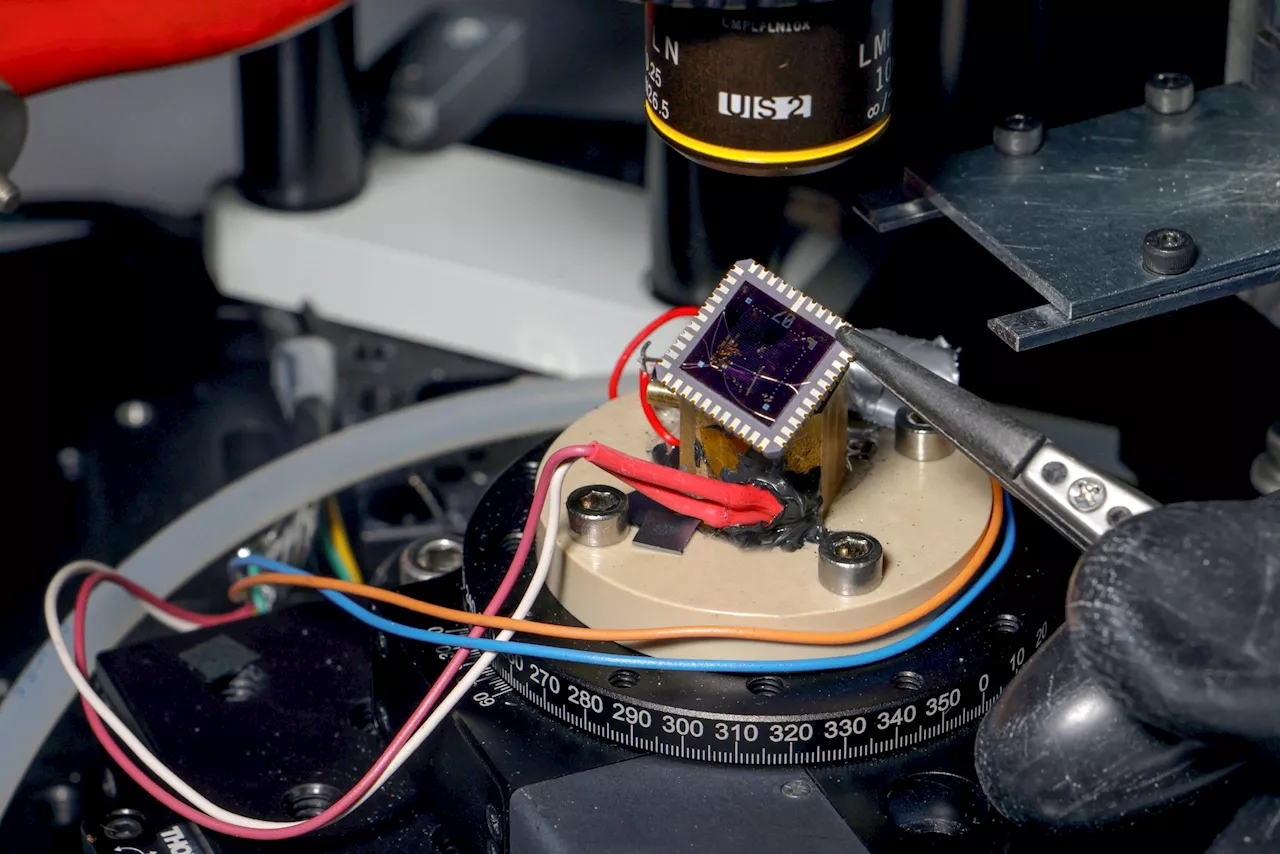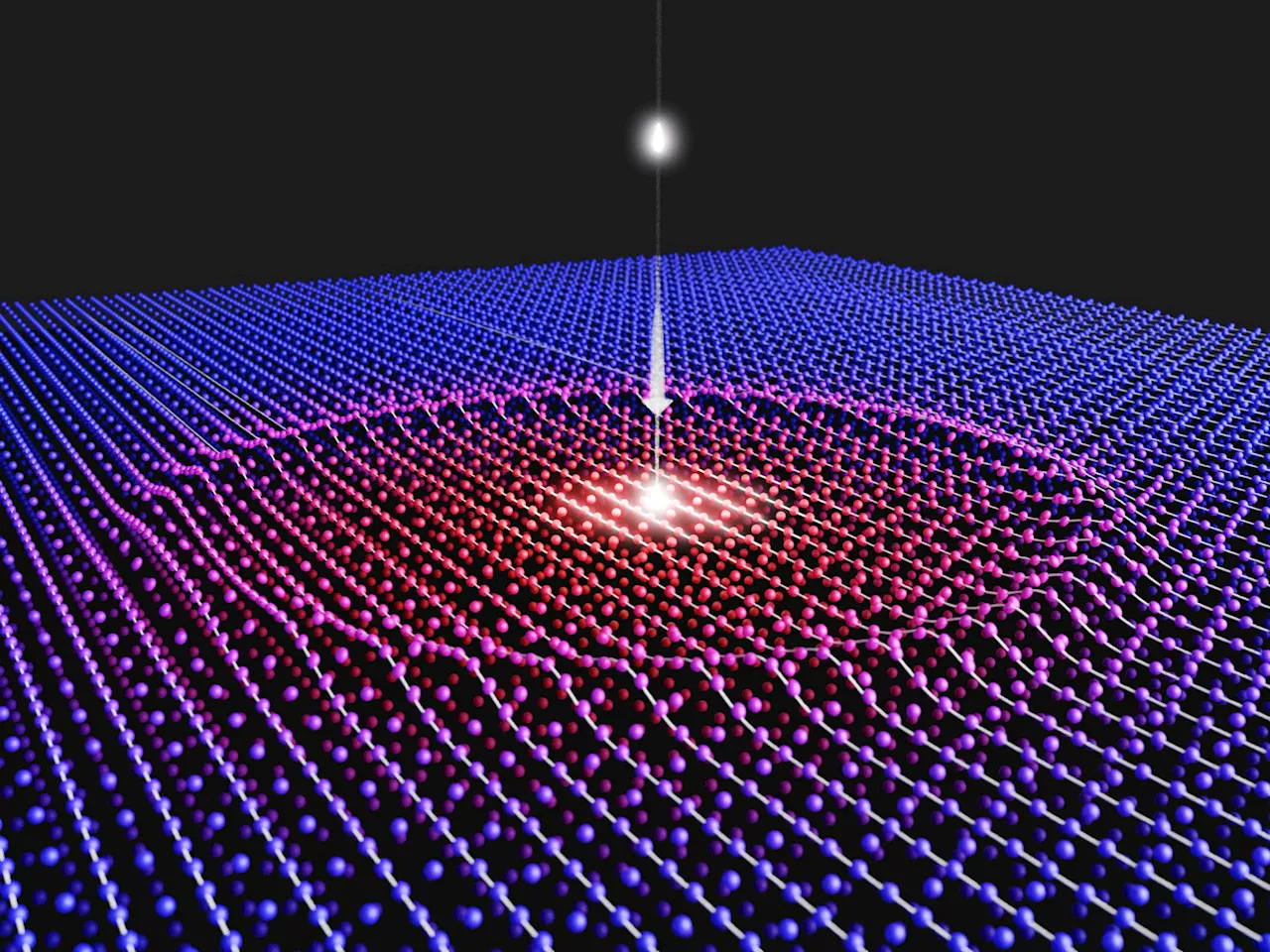Science, Space and Technology News 2024
Brookhaven scientists used their new ultrafast pair distribution function technique to explore the transition of a quantum material to a previously undiscovered material phase. The above schematic shows how the absorption of a laser photon initiates a small change that propagates through the material over time, rather than instantaneously changing the whole material.
“It’s hard to imagine how fast a picosecond really is,” Griffiths said. In one second, light can travel around the Earth seven and a half times. But in one picosecond, light can only travel one third of a millimeter. “The time scales are almost incomparable.”So, the scientists brought the PDF technique to an XFEL called the Linac Coherent Light Source , a DOE Office of Science user facility at DOE’s SLAC National Accelerator Laboratory that generates incredibly bright and short pulses of X-rays.
The Brookhaven Lab research team : Longlong Wu, Ian Robinson, Jack Griffiths, Emil Bozin, and Mark Dean. Credit: Kevin Coughlin/Brookhaven National Laboratory“Getting PDF working with an XFEL was the result of a huge organizational effort,” said Ian Robinson, the X-ray Scattering Group leader at Brookhaven Lab and a professor at the London Centre for Nanotechnology at University College London .
Even though the laser light perturbed just a few atoms, those atoms’ neighbors responded to the change. And then the neighbors’ neighbors felt the impact, until the local change had propagated throughout the entire quantum material. Interestingly, the material was disordered for tens of picoseconds, “even though it started and ended in an ordered state,” Griffiths said.
United States Latest News, United States Headlines
Similar News:You can also read news stories similar to this one that we have collected from other news sources.
 Atomic 'GPS' elucidates movement during ultrafast material transitionsScientists from the U.S. Department of Energy's (DOE) Brookhaven National Laboratory have created the first-ever atomic movies showing how atoms rearrange locally within a quantum material as it transitions from an insulator to a metal.
Atomic 'GPS' elucidates movement during ultrafast material transitionsScientists from the U.S. Department of Energy's (DOE) Brookhaven National Laboratory have created the first-ever atomic movies showing how atoms rearrange locally within a quantum material as it transitions from an insulator to a metal.
Read more »
 Atomic 'GPS' elucidates movement during ultrafast material transitionsScientists have created the first-ever atomic movies showing how atoms rearrange locally within a quantum material as it transitions from an insulator to a metal.
Atomic 'GPS' elucidates movement during ultrafast material transitionsScientists have created the first-ever atomic movies showing how atoms rearrange locally within a quantum material as it transitions from an insulator to a metal.
Read more »
 Quantum sensor for the atomic world | ScienceDailyIn a scientific breakthrough, an international research team has developed a quantum sensor capable of detecting minute magnetic fields at the atomic length scale. This pioneering work realizes a long-held dream of scientists: an MRI-like tool for quantum materials.
Quantum sensor for the atomic world | ScienceDailyIn a scientific breakthrough, an international research team has developed a quantum sensor capable of detecting minute magnetic fields at the atomic length scale. This pioneering work realizes a long-held dream of scientists: an MRI-like tool for quantum materials.
Read more »
 An MRI-like tool for quantum materials: Sensor can detect minute magnetic fields at atomic scaleAn international research team from Germany's Forschungszentrum Jülich and Korea's IBS Center for Quantum Nanoscience (QNS) has developed a quantum sensor capable of detecting minute magnetic fields at the atomic-length scale. This pioneering work realizes a long-held dream of scientists: an MRI-like tool for quantum materials.
An MRI-like tool for quantum materials: Sensor can detect minute magnetic fields at atomic scaleAn international research team from Germany's Forschungszentrum Jülich and Korea's IBS Center for Quantum Nanoscience (QNS) has developed a quantum sensor capable of detecting minute magnetic fields at the atomic-length scale. This pioneering work realizes a long-held dream of scientists: an MRI-like tool for quantum materials.
Read more »
 Quantum Breakthrough: MRI for Molecules Unlocks Secrets of the Atomic WorldScience, Space and Technology News 2024
Quantum Breakthrough: MRI for Molecules Unlocks Secrets of the Atomic WorldScience, Space and Technology News 2024
Read more »
 Overcoming Longstanding Quantum Computing Roadblock: Scientists Develop Efficient 2D Device for Quantum CoolingScience, Space and Technology News 2024
Overcoming Longstanding Quantum Computing Roadblock: Scientists Develop Efficient 2D Device for Quantum CoolingScience, Space and Technology News 2024
Read more »
